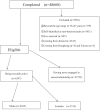Prevalence of and factors associated with unintended pregnancies among sexually active undergraduates in mainland China
- PMID: 35854377
- PMCID: PMC9297568
- DOI: 10.1186/s12978-022-01461-3
Prevalence of and factors associated with unintended pregnancies among sexually active undergraduates in mainland China
Abstract
Background: Unintended pregnancies (UIP) among unmarried sexually active college students in mainland China have emerged as a major reproductive health issue with detrimental personal and socioeconomic consequences. This cross-sectional study aimed to determine the prevalence and factors associated with UIP among sexually active undergraduates in mainland China.
Methods: Between September 8, 2019 and January 17, 2020, a total of 48,660 participants were recruited across the Chinese mainland to complete the self-administered, structured, online questionnaire. This analysis was restricted to 6347 sexually experienced, never-married 15-26 year old undergraduates. Pearson's Chi square tests and multivariate Logistic regression analyses were performed to identify sociodemographic, familial and individual variables associated with UIP.
Results: The overall prevalence of UIP was 17.7%. More specifically, 19.5% of male college students reported they had unintentionally gotten a partner pregnant, while 14.9% of female college students became unintentionally pregnant. Students who experienced UIP were more likely to belong to the older age group (23-26 years), live with only one parent or live without parents at home, report that their family members approve of premarital sex, initiate sexual activity younger than 14 years old and have casual sex partners. Furthermore, females with multiple partners and males who came from low- income households, experienced sexual abuse, perceived difficulties in acquiring condoms and did not know how to use condoms correctly were also at higher risk of experiencing an unintended pregnancy.
Conclusion: In order to prevent UIP, a comprehensive intervention measure should be taken to target older students and those engaging in risky sexual behaviors, work with young male students to improve condom use skills, improve the availability of free condoms, optimize the involvement of parents and other family members in their children's sex education.
Keywords: Prevalence; Risk factors; Undergraduates; Unintended pregnancies.
Plain language summary
In this study, we aimed to determine the prevalence and factors associated with UIP among sexually active undergraduates in mainland China. Between September 8, 2019 and January 17, 2020, a total of 48,660 participants were recruited from the Chinese mainland to complete the self-administered, structured, online questionnaire. This analysis was restricted to 6347 sexually experienced, never-married 15–26 year old undergraduates. Based on a social-ecological theoretical framework, we ran separate multivariate Logistic regression models for men and women to identify sociodemographic, familial and individual variables associated with UIP. Our findings indicate that the overall prevalence of UIP was 17.7%. More specifically, 19.5% of male college students reported they had unintentionally gotten a partner pregnant, while 14.9% of female college students became unintentionally pregnant. Students who experienced UIP were more likely to belong to the older age group, live with only one parent or live without parents at home, report that their family members approve of premarital sex, initiate sexual activity younger than 14 years old and have casual sex partners. Furthermore, females with multiple partners and males who came from low-income households, experienced sexual abuse, perceived difficulties in acquiring condoms and did not know how to use condoms correctly were also at higher risk of having an unintended pregnancy. In order to prevent UIP, a comprehensive intervention measure should be taken to target older students and those engaging in risky sexual behaviors, work with young male students to improve condom use skills, improve the availability of free condoms, optimize the involvement of parents and other family members in their children’s sex education.
© 2022. The Author(s).
Conflict of interest statement
The authors declare that there is no conflict of interest.
Figures
Similar articles
-
Ecological factors associated with child sexual abuse among 15- to 17-year-old adolescents in mainland China: implications for intervention.Front Public Health. 2023 Oct 20;11:1169669. doi: 10.3389/fpubh.2023.1169669. eCollection 2023. Front Public Health. 2023. PMID: 37927859 Free PMC article.
-
Inequities in consistent condom use among sexually experienced undergraduates in mainland China: implications for planning interventions.BMC Public Health. 2019 Aug 30;19(1):1195. doi: 10.1186/s12889-019-7435-4. BMC Public Health. 2019. PMID: 31470819 Free PMC article.
-
Premarital sexual behavior among male college students of Kathmandu, Nepal.BMC Public Health. 2009 Jul 15;9:241. doi: 10.1186/1471-2458-9-241. BMC Public Health. 2009. Retraction in: BMC Public Health. 2023 Jul 28;23(1):1445. doi: 10.1186/s12889-023-16374-4. PMID: 19604383 Free PMC article. Retracted.
-
Update on pregnancy, condom use, and prevalence of selected sexually transmitted diseases in adolescents.Curr Opin Obstet Gynecol. 1992 Dec;4(6):855-9. Curr Opin Obstet Gynecol. 1992. PMID: 1450350 Review.
-
Need for Sexual, Reproductive, and Mental Health Promotion Among Diverse College Students in a COVID-19 Era.Clin Child Fam Psychol Rev. 2023 Dec;26(4):1077-1096. doi: 10.1007/s10567-023-00460-5. Epub 2023 Nov 7. Clin Child Fam Psychol Rev. 2023. PMID: 37934361 Free PMC article. Review.
Cited by
-
Ecological factors associated with child sexual abuse among 15- to 17-year-old adolescents in mainland China: implications for intervention.Front Public Health. 2023 Oct 20;11:1169669. doi: 10.3389/fpubh.2023.1169669. eCollection 2023. Front Public Health. 2023. PMID: 37927859 Free PMC article.
-
Characteristics and contraceptive practices among Chinese women seeking abortion: a multicentre, descriptive study from 2019 to 2021.BMJ Sex Reprod Health. 2024 Oct 15;50(4):252-261. doi: 10.1136/bmjsrh-2023-202181. BMJ Sex Reprod Health. 2024. PMID: 38702180 Free PMC article.
-
Knowledge, Attitudes, and Practices Toward Contraceptive Methods Among Female Undergraduate Students of Chiang Mai University, Thailand: A Cross-Sectional Survey.Womens Health Rep (New Rochelle). 2025 Mar 5;6(1):221-229. doi: 10.1089/whr.2024.0126. eCollection 2025. Womens Health Rep (New Rochelle). 2025. PMID: 40130036 Free PMC article.
-
Frequency of health care provider recommendations for HPV vaccination: a survey in three large cities in China.Front Public Health. 2023 Jul 11;11:1203610. doi: 10.3389/fpubh.2023.1203610. eCollection 2023. Front Public Health. 2023. PMID: 37497028 Free PMC article.
References
-
- Zheng X, Chen G, Han Y, Chen H, Lin T, Qiu Y, et al. Survey of youth access to reproductive health in China. Popul Dev. 2010;16(3):2–16.
MeSH terms
Grants and funding
LinkOut - more resources
Full Text Sources
Miscellaneous


